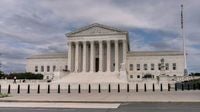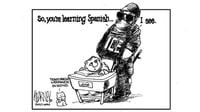The U.S. Supreme Court’s recent decision on immigration enforcement in Los Angeles is sending shockwaves through legal, political, and faith communities nationwide. On September 8, 2025, the Court handed down a 6-3 ruling that reverses a lower court’s order and, for now, clears the way for federal agents to use ethnicity among other factors in making immigration stops. The ruling, which comes as Immigration and Customs Enforcement (ICE) ramps up operations in cities like Chicago and Washington, has ignited fierce debate about racial profiling, constitutional rights, and the role of the Supreme Court’s so-called "shadow docket."
The case at the heart of the controversy began when U.S. District Judge Maame E. Frimpong in Los Angeles issued a restraining order in July 2025. That order barred ICE agents from stopping people solely based on race, language, job, or location—a set of restrictions that covered nearly 20 million people in the Central District of California, almost half of whom identify as Hispanic or Latino, according to WTTW News and AP reports. Judge Frimpong found a "mountain of evidence" that federal "roving patrols" were conducting indiscriminate stops, sometimes sweeping up U.S. citizens in their dragnet. Plaintiffs in the case included three detained immigrants and two U.S. citizens, one of whom, Brian Gavidia, was shown in a viral video being seized by agents as he protested, "I was born here in the States. East LA, bro!" He was released after showing his ID, as was another citizen stopped at a car wash.
But on September 8, the Supreme Court granted the government’s request to stay Judge Frimpong’s injunction, effectively lifting the restrictions on ICE’s ability to use a combination of factors—including ethnicity, language, and occupation—when making stops. The decision was made on the Court’s emergency or "shadow docket," which allows for expedited rulings without full written explanations. This practice has become more common in recent years, drawing criticism from legal scholars and advocates who argue it fosters confusion and undermines transparency.
"What the Supreme Court did on Monday was make a ruling on the so-called emergency docket ... granting the government’s request to stay an injunction that was put in place by a federal district judge out in Los Angeles," explained Kevin Fee, legal director for the American Civil Liberties Union (ACLU) of Illinois, in an interview with WTTW News. "The practical effect of that is potentially pretty profound because it lifts the shackles that had previously been placed by the district court on ICE agents to engage in racial profiling. So it could have very real immediate harm."
While the ruling does not explicitly legalize racial profiling, it does make it easier for ICE agents to conduct stops based on a combination of factors. "Individuals could still petition a court for relief based on pure racial profiling, and they could very well get relief," Fee noted. "The thing that’s happened is that the broad injunction ... that prevented a specific practice of stopping people only based on a combination of race, language status, location and job status is stricken. So now it’s going to have to be looked at on a more case-by-case basis." The ruling, Fee emphasized, "does not repeal the Fourth Amendment. Monday’s ruling is not a full-throated endorsement of racial profiling, even if the practical impact of it is to make racial profiling easier and less risky for ICE agents to conduct. But racial profiling is unconstitutional."
Justice Brett Kavanaugh, writing in concurrence with the majority’s brief order, said, "To be clear, apparent ethnicity alone cannot furnish reasonable suspicion; under this Court’s case law regarding immigration stops, however, it can be a ‘relevant factor’ when considered along with other salient factors." He suggested that stops involving force could still face legal challenges. However, Justice Sonia Sotomayor, in a stinging dissent joined by Justices Elena Kagan and Ketanji Brown Jackson, warned, "Countless people in the Los Angeles area have been grabbed, thrown to the ground, and handcuffed simply because of their looks, their accents, and the fact they make a living by doing manual labor. Today, the Court needlessly subjects countless more to these exact same indignities."
The timing of the Supreme Court’s decision is significant. It coincides with the U.S. Department of Homeland Security’s announcement of "Operation Midway Blitz," which is expected to ramp up ICE’s presence in Chicago and the surrounding areas. Meanwhile, ICE enforcement is also intensifying in Washington, amid the federal government’s increased control over local law enforcement and the deployment of the National Guard.
The ruling has drawn sharp criticism from immigrant advocacy groups, who argue that the Trump administration’s enforcement tactics systematically target brown-skinned people. The lawsuit against the administration was filed by such groups, who say the new legal landscape exposes millions to "significant intrusions on their liberty." According to the plaintiffs’ attorneys, "Numerous U.S. citizens and others who are lawfully present in this country have been subjected to significant intrusions on their liberty. Many have been physically injured; at least two were taken to a holding facility."
On the other side, the Department of Homeland Security and the Justice Department maintain that immigration officers target people based on illegal presence in the U.S., not on skin color, race, or ethnicity. They argued that Judge Frimpong’s order was overly restrictive and threatened agents with sanctions if courts doubted their reliance on additional factors in making stops. The Solicitor General, D. John Sauer, also contended that the order could not stand under the Supreme Court’s recent decisions restricting universal injunctions.
Faith leaders have also weighed in. On September 11, the Evangelical Lutheran Church in America (ELCA) issued a statement condemning the Supreme Court’s decision. Presiding Bishop Elizabeth Eaton called the ruling "unjust and inhumane, rooted in racism," and affirmed the dignity of the Latino community as "children of God." The ELCA called on its congregations to advocate for the reversal of discriminatory practices and the protection of constitutional safeguards, offering resources from its AMMPARO program and social teachings to support vulnerable neighbors.
Legal experts remain concerned about the Supreme Court’s increased use of the shadow docket. "It really does raise folks’ concerns that the court is being used in a partisan way," Fee said. "It also is concerning because it results in interim decisions that have real, and in some cases, profound ongoing harm on people." The lack of full reasoning from the Court leaves lower courts and attorneys "in the dark" about how to proceed, leading to what Fee described as "a sort of chaos when it comes to interpreting and challenging the actions of this administration."
As the lawsuit continues to unfold in California, the Supreme Court’s decision means ICE agents now face fewer legal constraints when making immigration stops in Los Angeles and, potentially, elsewhere. The case could take months or longer to reach a full hearing before the Court, leaving millions in limbo—and many advocates and community leaders on high alert.
The landscape of immigration enforcement and constitutional rights in the United States remains deeply unsettled, with the Supreme Court’s ruling marking a pivotal, and hotly contested, turning point.


